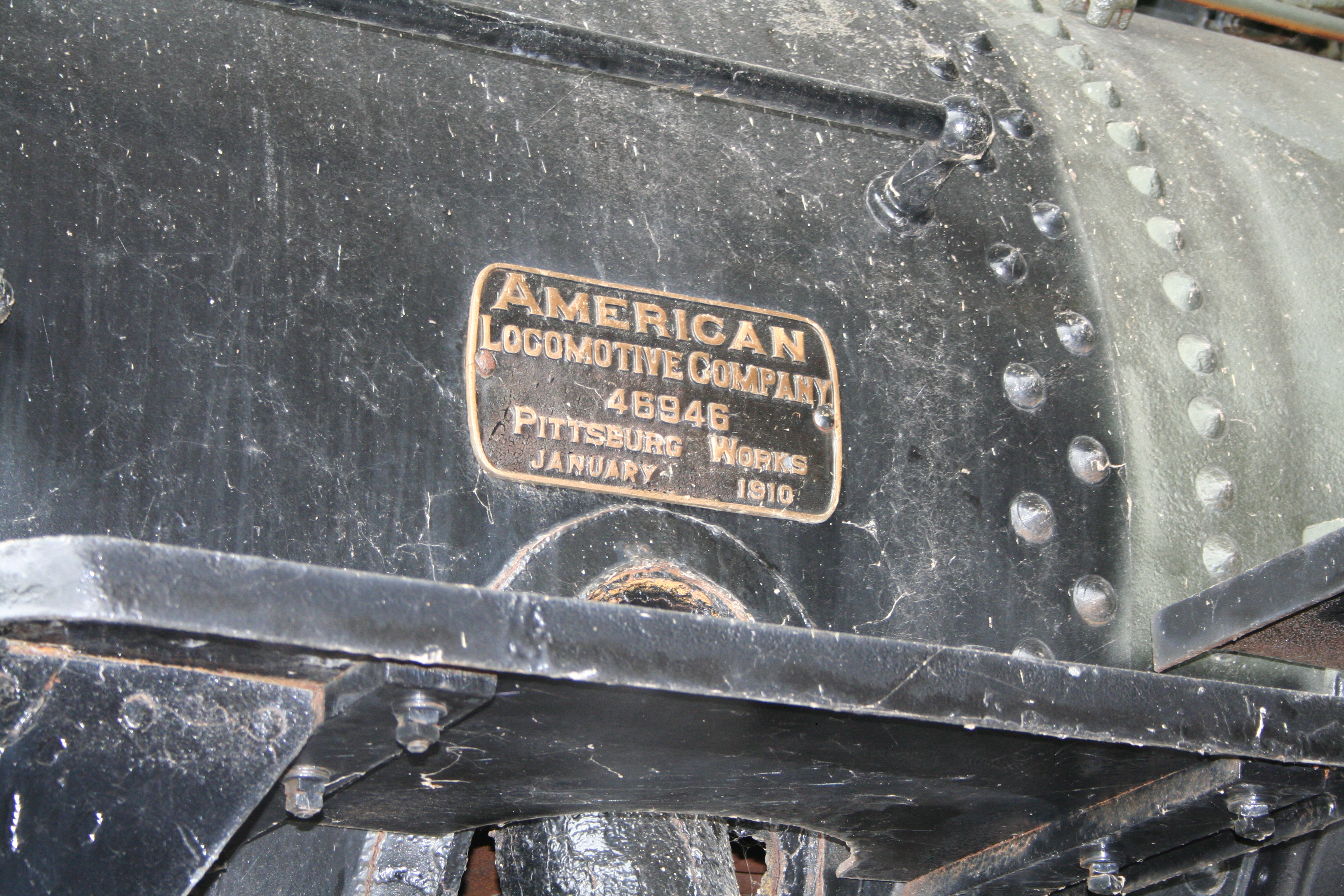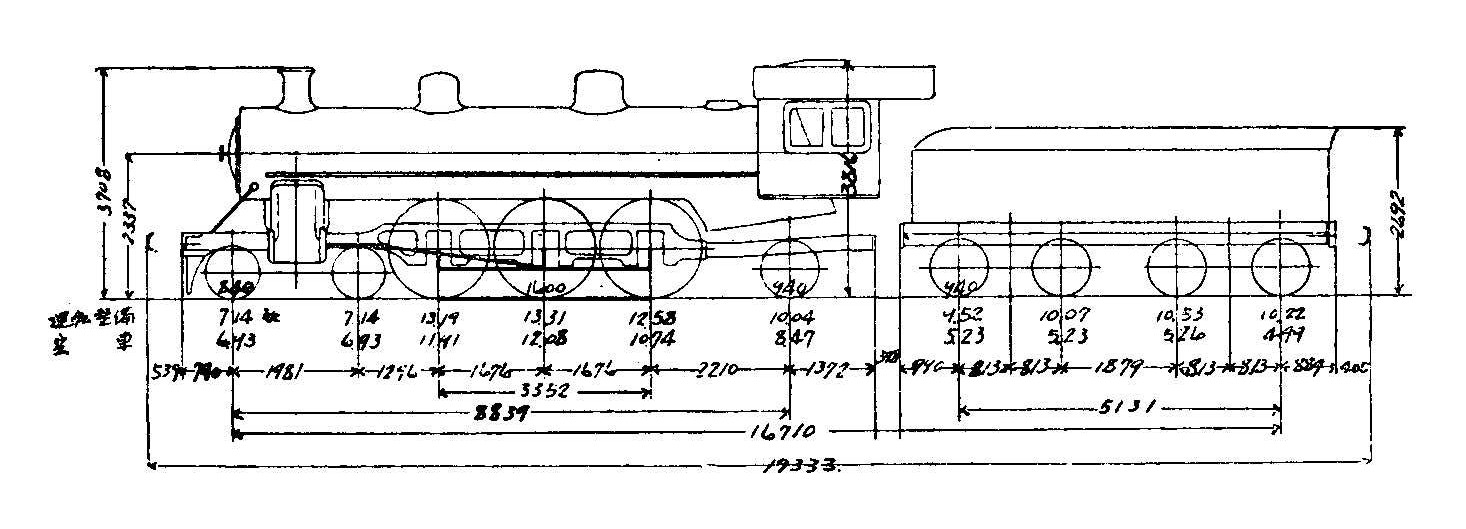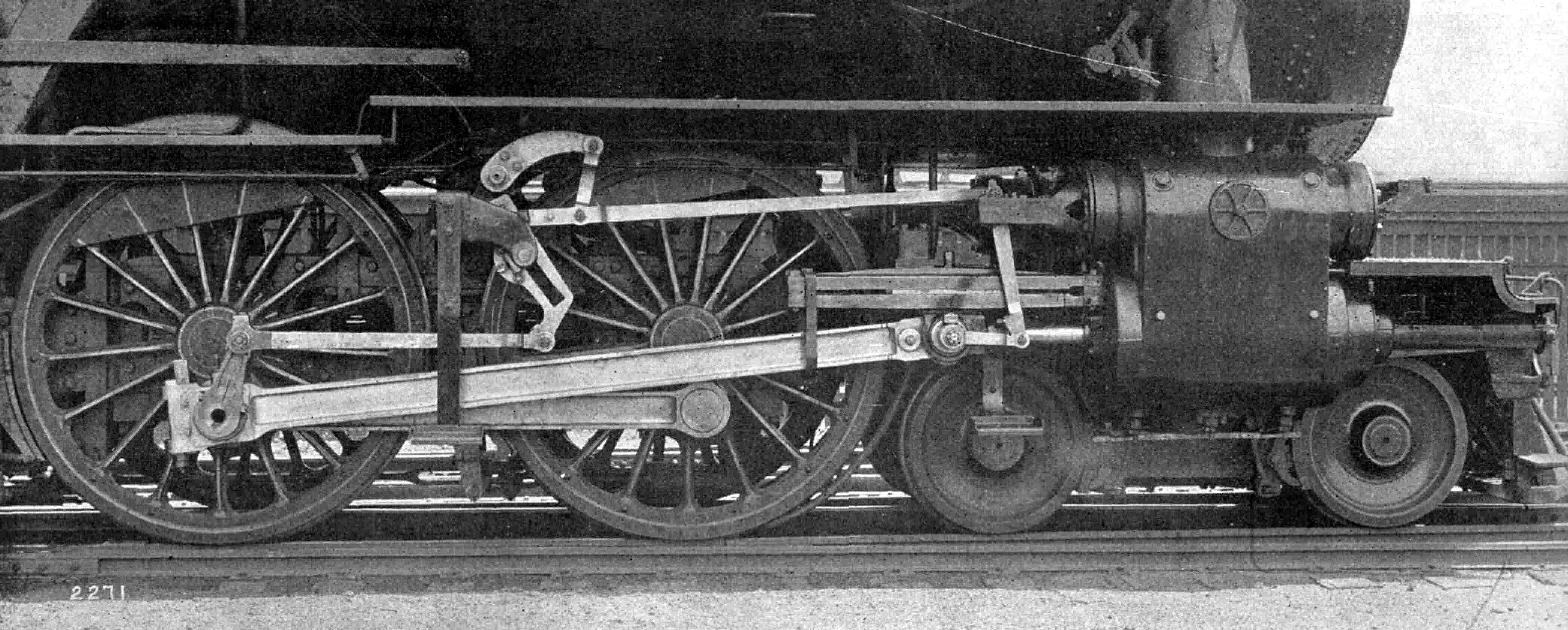|
JNR Class C52
The is a type of 4-6-2 steam locomotive built by the American Locomotive Company for the Japanese Government Railways in 1925. The locomotives were originally classified as the 8200 class under the JGR locomotive classification system. They were acquired to sample the latest American three-cylinder conjugated valve gear steam technology; as a consequence only six – the minimum order – were purchased and the tenders were built locally by Hitachi. They were the last Japanese steam locomotives to be imported. These served as an exemplary forerunner to the C53. File: JGR-C52049.jpg, Drawing (before renovation) See also * Japan Railways locomotive numbering and classification *JGR Class 8900 *JNR Class C51 *JNR Class C53 The is a type of 4-6-2 steam locomotive built in Japan from 1928 to 1929 designed by Hideo Shima and built by Kawasaki Heavy Industries Rolling Stock Company Kisha Seizo and Mitsubishi Heavy Industries and Hitachi . A total of 97 Class C53 ... Re ... [...More Info...] [...Related Items...] OR: [Wikipedia] [Google] [Baidu] |
American Locomotive Company
The American Locomotive Company (often shortened to ALCO, ALCo or Alco) was an American manufacturer of locomotives, diesel generators, steel, and tanks that operated from 1901 to 1969. The company was formed by the merger of seven smaller locomotive manufacturers and Schenectady Locomotive Works, Schenectady Locomotive Engine Manufactory of Schenectady, New York. A subsidiary, American Locomotive Automobile Company, designed and manufactured automobiles under the Alco brand from 1905 to 1913. ALCO also produced nuclear reactors from 1954 to 1962. The company changed its name to Alco Products, Incorporated in 1955. In 1964, the Worthington Corporation acquired the company. The company went out of business in 1969. The ALCO name is currently being used by Fairbanks-Morse, Fairbanks Morse Engine for their FM, ALCO line. Foundation and early history The company was created in 1901 from the merger of seven smaller locomotive manufacturers with Schenectady Locomotive Works, Schenect ... [...More Info...] [...Related Items...] OR: [Wikipedia] [Google] [Baidu] |
Japan Railways Locomotive Numbering And Classification
This page explains the numbering and classification schemes for locomotives employed by the Japanese Government Railways, the Japanese National Railways and the Japan Railways Group. Steam locomotives Pre-nationalization Prior to the nationalization of Japanese railways in 1906 and 1907, the government-run railways had numbered their steam locomotives only with serial numbers without consideration of the types of the locomotives. From the beginning of the Kobe–Osaka railway in 1874, they allocated odd numbers to locomotives in Tokyo area and even numbers to locomotives in Kobe area, but this custom was not maintained after the completion of railway between Tokyo and Kobe in 1889. Later, some locomotives, such as Classes A8 and B6 and rack railway locomotives, were renumbered to make groups for easy recognition of classes. Classes were introduced by Francis H. Trevithick (1850–1931), a grandson of Richard Trevithick, employed by the government of Japan for supervision of ... [...More Info...] [...Related Items...] OR: [Wikipedia] [Google] [Baidu] |
ALCO Locomotives
The American Locomotive Company (often shortened to ALCO, ALCo or Alco) was an American manufacturer of locomotives, diesel generators, steel, and tanks that operated from 1901 to 1969. The company was formed by the merger of seven smaller locomotive manufacturers and Schenectady Locomotive Engine Manufactory of Schenectady, New York. A subsidiary, American Locomotive Automobile Company, designed and manufactured automobiles under the Alco brand from 1905 to 1913. ALCO also produced nuclear reactors from 1954 to 1962. The company changed its name to Alco Products, Incorporated in 1955. In 1964, the Worthington Corporation acquired the company. The company went out of business in 1969. The ALCO name is currently being used by Fairbanks Morse Engine for their FM, ALCO line. Foundation and early history The company was created in 1901 from the merger of seven smaller locomotive manufacturers with Schenectady Locomotive Engine Manufactory of Schenectady, New York: *Brooks Locomot ... [...More Info...] [...Related Items...] OR: [Wikipedia] [Google] [Baidu] |
Steam Locomotives Of Japan
Steam is a substance containing water in the gas phase, and sometimes also an aerosol of liquid water droplets, or air. This may occur due to evaporation or due to boiling, where heat is applied until water reaches the enthalpy of vaporization. Steam that is saturated or superheated is invisible; however, "steam" often refers to wet steam, the visible mist or aerosol of water droplets formed as water vapor condenses. Water increases in volume by 1,700 times at standard temperature and pressure; this change in volume can be converted into mechanical work by steam engines such as reciprocating piston type engines and steam turbines, which are a sub-group of steam engines. Piston type steam engines played a central role in the Industrial Revolution and modern steam turbines are used to generate more than 80% of the world's electricity. If liquid water comes in contact with a very hot surface or depressurizes quickly below its vapor pressure, it can create a steam explosion. ... [...More Info...] [...Related Items...] OR: [Wikipedia] [Google] [Baidu] |
1067 Mm Gauge Locomotives Of Japan
1 (one, unit, unity) is a number representing a single or the only entity. 1 is also a numerical digit and represents a single unit of counting or measurement. For example, a line segment of ''unit length'' is a line segment of length 1. In conventions of sign where zero is considered neither positive nor negative, 1 is the first and smallest positive integer. It is also sometimes considered the first of the infinite sequence of natural numbers, followed by 2, although by other definitions 1 is the second natural number, following 0. The fundamental mathematical property of 1 is to be a multiplicative identity, meaning that any number multiplied by 1 equals the same number. Most if not all properties of 1 can be deduced from this. In advanced mathematics, a multiplicative identity is often denoted 1, even if it is not a number. 1 is by convention not considered a prime number; this was not universally accepted until the mid-20th century. Additionally, 1 is the s ... [...More Info...] [...Related Items...] OR: [Wikipedia] [Google] [Baidu] |
JNR Class C53
The is a type of 4-6-2 steam locomotive built in Japan from 1928 to 1929 designed by Hideo Shima and built by Kawasaki Heavy Industries Rolling Stock Company Kisha Seizo and Mitsubishi Heavy Industries and Hitachi . A total of 97 Class C53 locomotives were built they operated until all 97 were retired in 1950. C53 45 is the only example of the class to be preserved. Preserved examples Today, only one Class C53 locomotive has been preserved in Japan, C53 45, at the Kyoto Railway Museum (formerly Umekoji Steam Locomotive Museum). File:Japanese-national-railways-C53-45-20111213.jpg, C53 45 preserved at Umekoji Steam Locomotive Museum in December 2011 File:Advertisement of Kawasaki Dockyard Company in 1930s.jpg, C53 Kawasaki Company File:JGR-C53SteamLocomotive.jpg, C53 10 steam engine File:Nagoya Station at the completion, 1937 (昭和12年 建物完成時の名古屋駅).jpg, C53 96 steam engine File:JNR-C5345.jpg, C53 45 steam loco frontview File:TheThirdCylinder of C53.jp ... [...More Info...] [...Related Items...] OR: [Wikipedia] [Google] [Baidu] |
JNR Class C51
The is a type of 4-6-2 steam locomotive built by Kisha Seizo Mitsubishi and Japanese National Railways (JNR) Hamamatsu Works . The C classification indicates three sets of driving wheels. The C51 introduced diameter driving wheels to Japan. C51s raised the average speed on the Tōkaidō Main Line from to . In 1930, a C51 hauled the first '' Tsubame'' (swallow) express, reducing travel time between and to 9 hours. China Railway class SL9 To alleviate a severe motive power shortage, sixteen JGR Class C51 locomotives, C51 8, 28, 30, 33 - 35, 88, 95, 96, 116, 130 - 132, 173, 175, and 178, all equipped with a Sumiyama feedwater heater, were converted to standard gauge and sent to the Central China Railway in 1939, where they operated primarily between Nanjing and Shanghai, at first with their original JGR numbers, later as パシナ (''Pashina'') class. After the Liberation of China and the establishment of the People's Republic, these became China Railway class ㄆㄒ9 (''PX9'') ... [...More Info...] [...Related Items...] OR: [Wikipedia] [Google] [Baidu] |
JGR Class 8900
The JGR Class 8900 was a type of 4-6-2 steam locomotive type formerly used in Japan by the Japanese Government Railways (JGR). The locomotives were built by the American Locomotive Company in the USA. They were the first 4-6-2 Pacific types used in Japan. They were numbered 8900-8935 they remained in service until 1957 when they were scrapped. And none are preserved. See also * Japan Railways locomotive numbering and classification *JNR Class C51 The is a type of 4-6-2 steam locomotive built by Kisha Seizo Mitsubishi and Japanese National Railways (JNR) Hamamatsu Works . The C classification indicates three sets of driving wheels. The C51 introduced diameter driving wheels to Japan. C51s ... References {{Japanloco 4-6-2 locomotives Steam locomotives of Japan 1067 mm gauge locomotives of Japan Passenger locomotives Scrapped locomotives ... [...More Info...] [...Related Items...] OR: [Wikipedia] [Google] [Baidu] |
Hitachi
() is a Japanese multinational corporation, multinational Conglomerate (company), conglomerate corporation headquartered in Chiyoda, Tokyo, Japan. It is the parent company of the Hitachi Group (''Hitachi Gurūpu'') and had formed part of the Nissan Group, Nissan ''zaibatsu'' and later DKB Group and Fuyo Group of companies before DKB and Fuji Bank (the core Fuyo Group company) merged into the Mizuho Financial Group. As of 2020, Hitachi conducts business ranging from Information technology, IT, including Artificial intelligence, AI, the Internet of things, Internet of Things, and big data, to infrastructure. Hitachi is listed on the Tokyo Stock Exchange and Nagoya Stock Exchange and its Tokyo listing is a constituent of the Nikkei 225 and TOPIX Core30 indices. It is ranked 38th in the 2012 Fortune Global 500 and 129th in the 2012 Forbes Global 2000. History Hitachi was founded in 1910 by electrical engineer Namihei Odaira (1874–1951) in Ibaraki Prefecture. The company's firs ... [...More Info...] [...Related Items...] OR: [Wikipedia] [Google] [Baidu] |
4-6-2
Under the Whyte notation for the classification of steam locomotives, represents the wheel arrangement of four leading wheels on two axles, six powered and coupled driving wheels on three axles and two trailing wheels on one axle. The locomotive became almost globally known as a Pacific type. Overview The introduction of the design in 1901 has been described as "a veritable milestone in locomotive progress". On many railways worldwide, Pacific steam locomotives provided the motive power for express passenger trains throughout much of the early to mid-20th century, before either being superseded by larger types in the late 1940s and 1950s, or replaced by electric locomotive, electric or diesel locomotive, diesel-electric locomotives during the 1950s and 1960s. Nevertheless, new Pacific designs continued to be built until the mid-1950s. The type is generally considered to be an enlargement of the 4-4-2 (locomotive), Atlantic type, although its NZR Q class (1901), prototype had ... [...More Info...] [...Related Items...] OR: [Wikipedia] [Google] [Baidu] |
Valve Gear
The valve gear of a steam engine is the mechanism that operates the inlet and exhaust valves to admit steam into the cylinder and allow exhaust steam to escape, respectively, at the correct points in the cycle. It can also serve as a reversing gear. It is sometimes referred to as the "motion". Purpose In the simple case, this can be a relatively simple task as in the internal combustion engine in which the valves always open and close at the same points. This is not the ideal arrangement for a steam engine, though, because greatest power is achieved by keeping the inlet valve open throughout the power stroke (thus having full boiler pressure, minus transmission losses, against the piston throughout the stroke) while peak efficiency is achieved by only having the inlet valve open for a short time and then letting the steam expand in the cylinder (expansive working). The point at which steam stops being admitted to the cylinder is known as the '' cutoff'', and the optimal positio ... [...More Info...] [...Related Items...] OR: [Wikipedia] [Google] [Baidu] |







.jpg)
